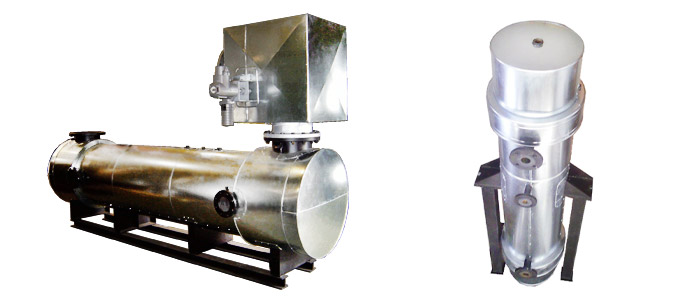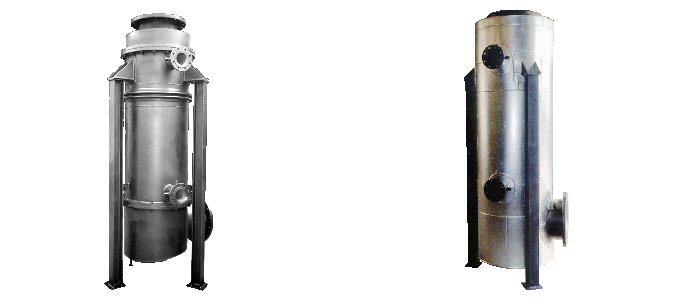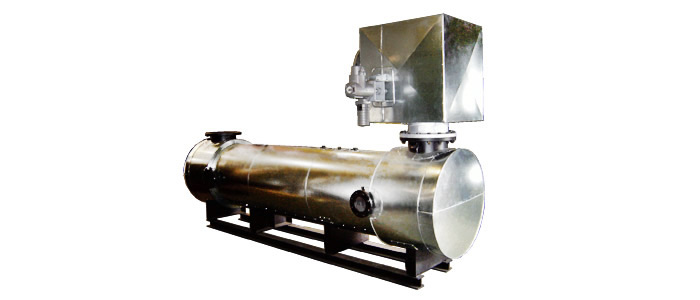SERIES "PH" and "PR"
exchangers or heat recovery PH and PR PRODINCO series are specially built for applications where it is desired to recover the heat contained in the exhaust of reciprocating engines running both GAS as Diesel, supporting high temperatures and pulsating gas flow. Inside tubes for circulating the gases in one or two steps and the exterior and interior of the sleeve, circulates cross countercurrent water.
By design, they allow installed in any position, both horizontally and vertically. Series "PR"
By design, they allow installed in any position, both horizontally and vertically.
- Flanges connecting the flue (plenums) and general water distribution network, adjustable.
- facilitating coupling to the specific conditions of the installation.
- The input and / or output of gas may be at an angle of 90 ° or straight as required Project.
- Make smooth straight tubes two mounting plates and housed in a cylindrical shell equipped with baffles and separators.
- Body pressure gas passage designed according to UNE-9300, NF, etc.
Series "PR"
- Tubes, tube support baffles and interior stainless steel spacer plates. ISI-304 -. 316
- Virola and plenums input / output gases in carbon steel alloy endowed with metallic expansion compensator.
- design pressure 60 mbar to 10 bar gas side and the water side.
Series "PH"
- Make tubular St.35.8.1 DIN-17175.
- Plates, sleeves, baffles, etc. quality boiler sheet H-II and / or 15 Mo3.
- Minimum pressure design 8 bar water side and 70 mbar gas side.
On request we can build different versions such as all stainless steel, with end zone for working gas condensation for pressures greater design, etc.
are supplied uninsulated to facilitate handling and equipped with bosses for water, gas, thermometers, safety valves, drain condensation, etc., also it incorporates two flanged to shell easily supports adjustable.
Applications:
The application of the principles of heat transfer to the design team to cover a certain object in engineering is crucial because, in applying the principles to the design, is should work towards the important achievement that involves the development of a product for economic advantage.
Parallel flows exchangers are generally used in liquid-liquid heat exchange while cross flow are generally used in the gas-liquid exchange.
it is called heat exchangers parallel to those in which both fluids circulate parallel directions in space flows. If, in addition to the two flows the same direction, have the same sense, are called "in co-current", which are called the "upstream" to those in which the flows are opposite directions.
In the Heat Exchangers Shell and tube is normal to combine the above classification to another based on the number of times each particle crosses the exchanger fluid, receiving the name passing each course; so exchangers in co-current or counter-changer would be a step by step shell and tubes.
The basic components of this exchanger are: The tube bundle, casing heads or plenums, baffles and the tubular plate .
Heat:
The tubes are the basic components, providing the surface heat transfer between the fluid circulating inside the tubes and the housing. The tubes may be complete or soldiers and generally are made from copper or steel alloys. Other alloys of nickel, titanium or aluminum may be required for specific applications.
The tubes may be finned or bare. The extended surfaces are used when one of the fluids has a transfer coefficient much lower than the other fluid heat. The double finned tubes can further improve efficiency. The fins provide two to four times the area of heat transfer tube would provide bare. The number of tube passes through the housing and depend on the pressure drop available. At higher speeds increase the heat transfer coefficients but also friction losses and erosion in the materials. Therefore, if the pressure loss is acceptable, it is advisable to have fewer but longer tubes in a small area.
tubular plate:
The tubes are held in place by being inserted into holes in the tube plate, fixing by expansion or welding. The tubesheet is usually a simple metal plate that has been drilled to accommodate the tubes (the desired pattern), the gaskets and bolts. In the event that an extra leakage protection required double tubesheet may be used.
For hazardous applications a triple tube plate, seals and even gaseous recirculation system leaks can be used.
Tubesheet addition to their mechanical requirements can withstand the corrosive attack of both fluids exchanger and is electrochemically compatible with the tube material.
Baffles:
There are two types of deflectors: transverse and longitudinal. The purpose of the longitudinal baffles is to control the general direction of flow of the shell side. The transverse baffles have two functions, the most important is to keep the tubes in position during operation and prevents vibration caused by flow induced vortices. Second, they guide the fluid side of the housing to come as close as possible to the characteristics of cross flow.
The most common is the simple segmented reflector.
Housing and plenums:
The case is the envelope of the second fluid, and plenums are the input and output ports. The housing is generally circular section and is made of a steel plate formed into a cylindrical shape and welded. Cases small diameters (up to 24 inches) can be made by cutting a desired diameter tube to the correct length.
In large heat exchangers, the housing is made of carbon steel wherever possible for reasons of economy although other alloys can also be used as corrosion or high temperatures require it.
The plenums simply direct the flow of fluid from tube side to the inside or outside of the exchanger tubes. They are addressable, allowing better installation.
On request we can build different versions such as all stainless steel, with end zone for working gas condensation for pressures greater design, etc. are supplied uninsulated to facilitate handling and equipped with bosses for water, gas, thermometers, safety valves, drain condensation, etc., also it incorporates two flanged to shell easily supports adjustable.
Applications:
The application of the principles of heat transfer to the design team to cover a certain object in engineering is crucial because, in applying the principles to the design, is should work towards the important achievement that involves the development of a product for economic advantage.
Parallel flows exchangers are generally used in liquid-liquid heat exchange while cross flow are generally used in the gas-liquid exchange. it is called heat exchangers parallel to those in which both fluids circulate parallel directions in space flows. If, in addition to the two flows the same direction, have the same sense, are called "in co-current", which are called the "upstream" to those in which the flows are opposite directions.
In the Heat Exchangers Shell and tube is normal to combine the above classification to another based on the number of times each particle crosses the exchanger fluid, receiving the name passing each course; so exchangers in co-current or counter-changer would be a step by step shell and tubes. The basic components of this exchanger are: The tube bundle, casing heads or plenums, baffles and the tubular plate .
Heat:
The tubes are the basic components, providing the surface heat transfer between the fluid circulating inside the tubes and the housing. The tubes may be complete or soldiers and generally are made from copper or steel alloys. Other alloys of nickel, titanium or aluminum may be required for specific applications. The tubes may be finned or bare. The extended surfaces are used when one of the fluids has a transfer coefficient much lower than the other fluid heat. The double finned tubes can further improve efficiency. The fins provide two to four times the area of heat transfer tube would provide bare. The number of tube passes through the housing and depend on the pressure drop available. At higher speeds increase the heat transfer coefficients but also friction losses and erosion in the materials. Therefore, if the pressure loss is acceptable, it is advisable to have fewer but longer tubes in a small area.
tubular plate:
The tubes are held in place by being inserted into holes in the tube plate, fixing by expansion or welding. The tubesheet is usually a simple metal plate that has been drilled to accommodate the tubes (the desired pattern), the gaskets and bolts. In the event that an extra leakage protection required double tubesheet may be used. For hazardous applications a triple tube plate, seals and even gaseous recirculation system leaks can be used. Tubesheet addition to their mechanical requirements can withstand the corrosive attack of both fluids exchanger and is electrochemically compatible with the tube material.
Baffles:
There are two types of deflectors: transverse and longitudinal. The purpose of the longitudinal baffles is to control the general direction of flow of the shell side. The transverse baffles have two functions, the most important is to keep the tubes in position during operation and prevents vibration caused by flow induced vortices. Second, they guide the fluid side of the housing to come as close as possible to the characteristics of cross flow. The most common is the simple segmented reflector.
Housing and plenums:
The case is the envelope of the second fluid, and plenums are the input and output ports. The housing is generally circular section and is made of a steel plate formed into a cylindrical shape and welded. Cases small diameters (up to 24 inches) can be made by cutting a desired diameter tube to the correct length. In large heat exchangers, the housing is made of carbon steel wherever possible for reasons of economy although other alloys can also be used as corrosion or high temperatures require it. The plenums simply direct the flow of fluid from tube side to the inside or outside of the exchanger tubes. They are addressable, allowing better installation.




